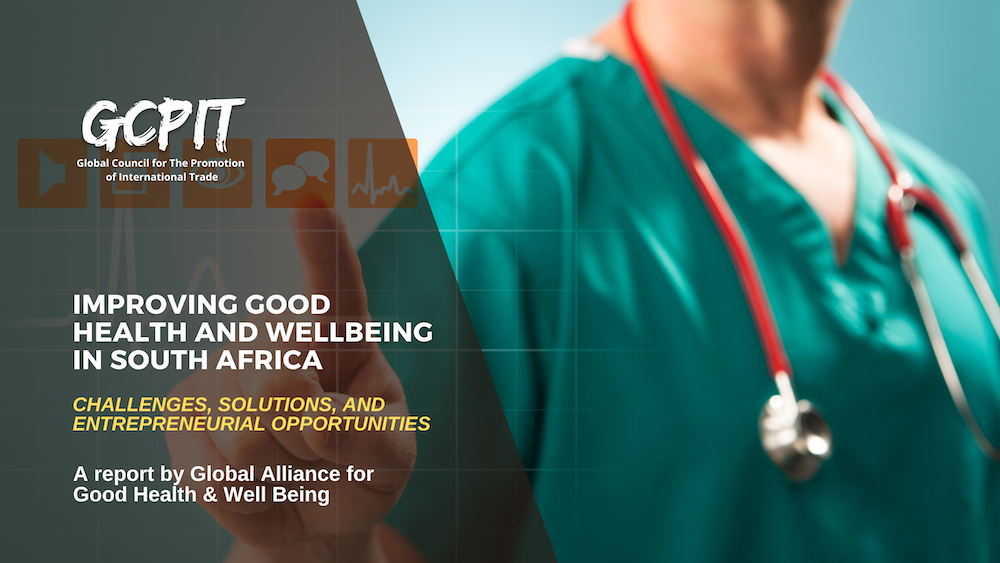
Good health and wellbeing is an essential element of human development, and it is a fundamental human right that everyone should enjoy. In South Africa, the provision of quality healthcare has been a significant challenge due to various factors, including the high burden of disease, inadequate infrastructure, insufficient funding, and shortage of healthcare professionals. The country has made significant progress in improving the health status of its citizens, but more needs to be done to ensure universal access to quality healthcare services. This case study will analyze the challenges faced by South Africa in providing good health and wellbeing to its citizens and the solutions implemented to address these challenges.
Challenges: South Africa faces several challenges to achieve good health and wellbeing for its citizens. Despite progress in reducing some health indicators such as infant and child mortality, there are still several challenges that need to be addressed. The challenges range from social determinants such as poverty and inequality to health system challenges such as inadequate resources and workforce shortages. This section outlines the top ten challenges for good health and wellbeing in South Africa.
- HIV/AIDS: South Africa has one of the highest HIV prevalence rates in the world. According to UNAIDS, there were an estimated 7.5 million people living with HIV in South Africa in 2019, with 240,000 new infections and 71,000 AIDS-related deaths. The HIV epidemic continues to have a significant impact on the health and wellbeing of South Africans.
- Non-communicable diseases: Non-communicable diseases (NCDs) are responsible for 43% of all deaths in South Africa. The most prevalent NCDs include cardiovascular diseases, cancer, diabetes, and chronic respiratory diseases. These diseases are largely preventable through lifestyle changes such as healthy eating, physical activity, and avoiding tobacco and excessive alcohol consumption.
- Maternal and child health: South Africa has made progress in reducing maternal and child mortality rates. However, maternal mortality rates are still high, with an estimated 119 deaths per 100,000 live births in 2015. The country also faces challenges related to adolescent pregnancies, low birth weight, and infant mortality.
- Tuberculosis: South Africa has one of the highest tuberculosis (TB) burdens in the world, with an estimated 301,000 cases in 2019. TB is often associated with poverty, overcrowding, and HIV co-infection. Treatment for TB can be lengthy and expensive, and drug-resistant strains of TB are a growing concern.
- Mental health: Mental health is an often-neglected aspect of healthcare in South Africa. There is a shortage of mental health professionals, and the stigma associated with mental illness often prevents people from seeking help. Depression and anxiety are the most prevalent mental health disorders in the country.
- Violence and injury: South Africa has one of the highest rates of violence and injury in the world. Interpersonal violence, including homicide and sexual violence, is a major contributor to premature death and disability. Road traffic accidents are also a significant cause of injury and death.
- Malnutrition: Malnutrition is a significant challenge in South Africa, with high rates of both undernutrition and obesity. According to the South African National Health and Nutrition Examination Survey (SANHANES), 27% of adults are overweight, and 9.6% are obese. In children under five years of age, 27% are stunted, indicating chronic undernutrition.
- Health system challenges: South Africa’s healthcare system faces several challenges, including inadequate resources, an unequal distribution of healthcare services, and a shortage of healthcare workers. The public healthcare system is often overburdened, with long waiting times and a lack of essential medicines and equipment.
- Environmental health: Environmental health hazards such as air pollution, water pollution, and climate change have significant impacts on health in South Africa. The country also faces challenges related to inadequate sanitation and access to clean drinking water, which increases the risk of waterborne diseases.
-
Social determinants of health: Social determinants such as poverty, unemployment, and inequality have a significant impact on health in South Africa. These factors contribute to poor living conditions, inadequate access to healthcare, and a lack of education and employment opportunities, which in turn can lead to poor health outcomes.
Solutions Implemented by the Country: South Africa has a complex healthcare system with a mix of public and private providers. Despite the government’s efforts to improve the health and well-being of its citizens, the country still faces significant challenges. The high burden of HIV/AIDS, tuberculosis, and non-communicable diseases, coupled with a shortage of healthcare workers and limited resources, has resulted in a healthcare system that struggles to meet the needs of the population. However, South Africa has implemented several unique solutions to address these challenges and improve the overall health and well-being of its citizens.
- National Health Insurance: In 2012, South Africa introduced the National Health Insurance (NHI) system to provide universal healthcare coverage for all citizens. The NHI aims to improve access to healthcare services, particularly for vulnerable and low-income populations. The program will be rolled out in phases, with pilot projects currently underway in several districts.
- Community Health Workers: South Africa has trained and deployed over 38,000 community health workers (CHWs) to provide basic healthcare services in underserved areas. These CHWs play a critical role in addressing the shortage of healthcare workers and improving access to primary healthcare services.
- Prevention of Mother-to-Child Transmission of HIV: South Africa has made significant progress in reducing the rate of mother-to-child transmission of HIV. The country’s program to prevent mother-to-child transmission of HIV has been successful, with the rate of transmission falling from 8.5% in 2008 to 1.3% in 2020.
- Mobile Clinics: South Africa has implemented mobile clinics that travel to underserved areas to provide healthcare services. These clinics have been particularly effective in rural areas where access to healthcare services is limited.
- Expanded Program on Immunization: South Africa has implemented an Expanded Program on Immunization (EPI) to improve access to immunization services for children. The program has been successful in increasing the coverage of vaccines for children under the age of 1, with coverage rates exceeding 90%.
- National Strategic Plan on HIV, TB and STIs: South Africa has developed a National Strategic Plan on HIV, TB, and STIs to address the high burden of these diseases. The plan focuses on prevention, treatment, care, and support for people living with HIV, TB, and STIs.
- Mental Health: South Africa has recognized the importance of mental health and has implemented several programs to address the high burden of mental illness in the country. These programs include the National Mental Health Policy Framework and Strategic Plan, which aims to improve access to mental healthcare services.
- Health Promotion: South Africa has implemented several health promotion initiatives, including the Health Promotion Levy, which imposes a tax on sugary beverages to discourage consumption and reduce the prevalence of non-communicable diseases such as diabetes and obesity.
- School Health: South Africa has implemented a School Health Program that aims to promote the health and well-being of school-aged children. The program provides health education, screening, and referrals for children with health problems.
- Public-Private Partnerships: South Africa has implemented several public-private partnerships to improve the quality of healthcare services and address the shortage of healthcare workers. These partnerships involve collaborations between the government, private sector, and non-governmental organizations to improve access to healthcare services.
South Africa has implemented several unique solutions to address the challenges of providing quality healthcare services to its citizens. The National Health Insurance system, community health workers, prevention of mother-to-child transmission of HIV, mobile clinics, expanded program on immunization, national strategic plan on HIV, TB and STIs, mental health programs, health promotion initiatives, school health program, and public-private partnerships are all examples of successful initiatives that have improved the health and well-being of the population. However, more work needs to be done to ensure that these solutions are sustainable and effective in the long term.
Opportunities for entrepreneurs: South Africa provides various opportunities for entrepreneurs to develop innovative solutions to address the challenges of providing quality healthcare services. The government has been promoting entrepreneurship in healthcare through various initiatives and policies, and entrepreneurs can explore various opportunities in telemedicine, personalized medicine, health data analytics, medical devices, health education, mental health, healthcare financing, nutrition, and wellness.
- Telemedicine: The growing use of technology and telemedicine in South Africa has created opportunities for entrepreneurs to develop new solutions for providing remote healthcare services to the underserved populations. Entrepreneurs can develop telemedicine platforms that connect patients to healthcare providers and specialists.
- Personalized medicine: South Africa’s diverse population provides an opportunity for entrepreneurs to develop personalized medicine solutions that are tailored to the specific needs of individuals. Entrepreneurs can use genetic testing and data analytics to develop personalized treatments for various health conditions.
- Health data analytics: Entrepreneurs can leverage the vast amount of health data in South Africa to develop data analytics solutions that can help healthcare providers improve their services and patient outcomes. They can develop tools to track and analyze health data to identify patterns and trends.
- Medical devices: The growing demand for medical devices in South Africa presents an opportunity for entrepreneurs to develop new and innovative medical devices that can improve patient outcomes. Entrepreneurs can develop devices that are affordable and accessible to the underserved population.
- Health education: Entrepreneurs can develop health education programs and platforms that provide accurate and reliable information to the public. They can use technology to develop e-learning platforms and mobile applications that promote health literacy and awareness.
- Mental health: The increasing prevalence of mental health disorders in South Africa provides an opportunity for entrepreneurs to develop solutions that address mental health issues. They can develop telemedicine platforms and mobile applications that provide mental health services and support.
- Healthcare financing: Entrepreneurs can develop innovative financing solutions that make healthcare services more accessible and affordable to the underserved population. They can develop microinsurance schemes and other financing models that cater to the needs of low-income individuals.
- Nutrition: Entrepreneurs can develop innovative solutions that address the issues of malnutrition and poor dietary habits in South Africa. They can develop products and services that promote healthy eating habits and provide access to affordable and nutritious food.
- Wellness: Entrepreneurs can develop wellness programs and solutions that promote healthy lifestyles and prevent chronic diseases. They can use technology to develop wellness platforms and mobile applications that promote physical activity and healthy behaviors.
-
Public-private partnerships: Entrepreneurs can partner with the government and healthcare providers to develop innovative solutions that address the challenges of providing quality healthcare services in South Africa. They can leverage government resources and expertise to develop solutions that cater to the needs of the underserved population.
Outcome of the Solutions Implemented: South Africa has implemented various unique solutions to address the challenges of providing quality healthcare services to its citizens. These initiatives have yielded several positive outcomes that have improved the health and wellbeing of the population.
- National Health Insurance System (NHI): The implementation of the NHI has increased access to healthcare services and improved the quality of care for the most vulnerable and marginalized populations. The NHI aims to ensure equitable access to healthcare for all citizens, regardless of their socioeconomic status.
- Community Health Workers (CHWs): The deployment of CHWs has strengthened primary healthcare delivery in rural and underserved areas. CHWs provide healthcare services, health education, and support to communities, improving health-seeking behavior and promoting healthy lifestyles.
- Prevention of Mother-to-Child Transmission (PMTCT) of HIV: South Africa has made significant progress in reducing the transmission of HIV from mother to child. The implementation of PMTCT programs has resulted in a decline in new HIV infections in children.
- Mobile Clinics: The use of mobile clinics has increased access to healthcare services in remote and underserved areas. These clinics provide essential healthcare services to populations that have limited access to health facilities.
- Expanded Program on Immunization (EPI): South Africa’s EPI has contributed to the decline in vaccine-preventable diseases. The program ensures that children receive the necessary immunizations to prevent serious illnesses.
- National Strategic Plan on HIV, TB and STIs: The implementation of the National Strategic Plan has led to a decline in new HIV infections, an increase in the number of people receiving antiretroviral therapy, and a decrease in TB-related deaths.
- Mental Health Programs: South Africa has implemented various mental health programs to address the burden of mental illness. These initiatives have increased access to mental health services and support, reducing the stigma associated with mental illness.
- Health Promotion Initiatives: Health promotion initiatives have focused on creating awareness and promoting healthy lifestyles. These initiatives have been instrumental in reducing the burden of non-communicable diseases and promoting overall health and wellbeing.
- School Health Program: The School Health Program provides essential health services to children in schools, improving their health and wellbeing. This program has been successful in addressing the health needs of children, including vaccination, vision, and hearing screening, and health education.
- Public-Private Partnerships (PPPs): The implementation of PPPs has improved the quality of healthcare services by leveraging the strengths of the public and private sectors. PPPs have increased access to essential health services, technology, and innovation, improving the overall health and wellbeing of the population.
South Africa’s unique solutions have been successful in addressing the challenges of providing quality healthcare services to its citizens. These initiatives have resulted in several positive outcomes, including increased access to healthcare services, improved health-seeking behavior, and a decline in the burden of communicable and non-communicable diseases. Entrepreneurs have significant opportunities to contribute to the healthcare sector in South Africa by leveraging technology, innovation, and public-private partnerships to address the remaining challenges and improve the health and wellbeing of the population.
Implication of Private-public partnerships, alliances, and collaborations on country’s good health and wellbeing sector: Public-private partnerships (PPPs) and collaborations are critical to achieving good health and well-being for citizens in any country, including South Africa. These partnerships bring together the expertise, resources, and funding of both the public and private sectors to address the complex challenges of healthcare delivery.
One example of successful PPPs in South Africa is the partnership between the government and private sector companies to provide antiretroviral treatment (ART) to people living with HIV. Through this collaboration, the government provides free ART to patients, while the private sector provides funding, expertise, and support to improve the delivery of these services. This has led to a significant increase in the number of people on ART in the country, from 923,000 in 2009 to over 5 million in 2020.
Another successful PPP in South Africa is the partnership between the government and non-governmental organizations (NGOs) to provide community-based healthcare services. NGOs provide healthcare services and support in underserved communities, while the government provides funding, training, and oversight. This has led to improved access to healthcare services in these communities, resulting in better health outcomes.
Furthermore, collaborations between the government and international organizations such as the World Health Organization (WHO) have also been critical in improving health outcomes in South Africa. For example, the WHO has supported the country in developing and implementing policies and programs to address the HIV/AIDS epidemic, leading to significant reductions in HIV prevalence and mortality rates.
According to a report by the National Department of Health in South Africa, PPPs have been successful in improving healthcare delivery in the country, with notable achievements such as the expansion of healthcare services in underserved areas, improvements in health infrastructure, and increased access to essential medicines and technologies.
In addition, collaborations and alliances between different sectors, such as healthcare and technology, have also led to innovative solutions for addressing healthcare challenges. For example, partnerships between healthcare providers and technology companies have led to the development of telemedicine platforms, which enable remote healthcare consultations and improve access to healthcare services.
Overall, PPPs, collaborations, and alliances have significant implications for improving the health and well-being of citizens in South Africa. By bringing together the resources, expertise, and funding of different sectors, these partnerships can address the complex challenges of healthcare delivery and improve health outcomes for all.
Conclusion: The challenges faced by South Africa’s healthcare system are complex and multifaceted. However, the country has implemented several unique solutions to address these challenges, which have led to positive outcomes for the population. The National Health Insurance system, community health workers, prevention of mother-to-child transmission of HIV, mobile clinics, expanded program on immunization, national strategic plan on HIV, TB and STIs, mental health programs, health promotion initiatives, school health program, and public-private partnerships have all contributed to improving the health and well-being of South Africans.
While progress has been made, there is still much work to be done to ensure that all citizens have access to quality healthcare services. Entrepreneurship in healthcare offers many opportunities for addressing the remaining challenges and improving health outcomes. There are opportunities in telemedicine, digital health solutions, medical devices, personalized medicine, health education, nutrition, and mental health, among others.
Collaboration between the private and public sectors, as well as between different organizations, is crucial for addressing the challenges faced by South Africa’s healthcare system. Public-private partnerships, alliances, and collaborations have the potential to bring together the expertise and resources of different stakeholders to improve access to quality healthcare services and address health disparities. The success of the National Health Insurance system, community health workers, and prevention of mother-to-child transmission of HIV programs are examples of how collaboration between different stakeholders can lead to positive outcomes.
It is also important to prioritize investments in healthcare infrastructure, human resources, and technology to ensure that healthcare services are accessible and of high quality. This will require government support, private sector investment, and international aid.
The challenges faced by South Africa’s healthcare system require a multifaceted approach and collaboration between different stakeholders. The solutions implemented so far have led to positive outcomes, but more work needs to be done to ensure that all citizens have access to quality healthcare services. Entrepreneurship in healthcare offers many opportunities for addressing the remaining challenges, and collaboration between the private and public sectors is crucial for success.
Call to action: As we have discussed in this report, South Africa faces numerous challenges in providing quality healthcare services to its citizens, but there are also unique opportunities for entrepreneurs and innovators to make a positive impact. It is clear that collaboration between stakeholders in the public and private sectors is essential to improve the health and wellbeing of the population.
On behalf of the Global Alliance for Good Health and Wellbeing, we urge all stakeholders to take action and collaborate towards improving the health and wellbeing of the people of South Africa. The following are some suggested actions:
- Increase funding and resources for the implementation of successful initiatives, such as the National Health Insurance system, community health workers, and mental health programs.
- Encourage and support entrepreneurs and innovators to develop solutions that address the challenges faced by the healthcare system, including telemedicine, mobile clinics, and health data analytics.
- Foster partnerships between the public and private sectors to increase access to healthcare services, especially in underserved communities.
- Prioritize preventative healthcare measures, including education and awareness programs, and early detection and treatment of diseases.
- Address social determinants of health, including poverty, lack of education, and access to clean water and sanitation, which impact the health and wellbeing of the population.
- Increase the number of healthcare professionals and improve their training and working conditions to ensure they can provide quality healthcare services.
- Improve the quality and availability of healthcare infrastructure, including hospitals, clinics, and medical equipment.
- Foster a culture of health and wellbeing, including promoting healthy lifestyles, mental health awareness, and reducing stigma surrounding healthcare seeking behavior.
- Ensure equitable access to healthcare services for all members of society, regardless of socioeconomic status, gender, or race.
- Continuously monitor and evaluate healthcare initiatives to ensure they are effective and efficient in improving the health and wellbeing of the population.
These actions are not exhaustive, and we encourage all stakeholders to identify additional opportunities for collaboration and improvement. By working together, we can make significant strides towards achieving the Sustainable Development Goal of good health and wellbeing for all.
Let us take action and collaborate towards a healthier and more prosperous South Africa.
References:
- World Health Organization. (2021). South Africa: WHO statistical profile. Retrieved from https://www.who.int/gho/countries/zaf/country_profiles/en/
- National Department of Health South Africa. (2017). Strategic plan for the prevention and control of non-communicable diseases 2013-17. Retrieved from https://www.health-e.org.za/wp-content/uploads/2017/06/NCDs-Strategic-Plan-2013-2017.pdf
- Health Systems Trust. (2018). South African Health Review 2018. Retrieved from https://www.hst.org.za/publications/South%20African%20Health%20Reviews/SAHR%202018.pdf
- National Department of Health South Africa. (2017). National Health Insurance for South Africa: Towards universal health coverage. Retrieved from https://www.gov.za/sites/default/files/gcis_document/201707/40929gon477.pdf
- National Department of Health South Africa. (2019). Comprehensive service plan for the prevention and management of HIV and TB: A 10-year plan for South Africa (2019/20 – 2028/29). Retrieved from https://www.gov.za/sites/default/files/gcis_document/201912/CSM-Plan%20FINAL%20%2810%20Dec%202019%29.pdf
- National Department of Health South Africa. (2019). Mental health policy framework and strategic plan 2013-2020. Retrieved from https://www.health-e.org.za/wp-content/uploads/2019/06/MHPFSP-2013-2020.pdf
- National Department of Health South Africa. (2018). Human resources for health strategy for the health sector 2012/13 – 2016/17. Retrieved from https://www.gov.za/sites/default/files/gcis_document/201811/human-resource-strategy-health-2013-2017_0.pdf
- Department of Basic Education South Africa. (2020). Integrated school health policy. Retrieved from https://www.education.gov.za/Portals/0/Documents/Policies/Integrated%20School%20Health%20Policy.pdf?ver=2020-07-10-101031-407
- KPMG. (2019). Private health sector assessment in South Africa. Retrieved from https://home.kpmg/content/dam/kpmg/za/pdf/2019/01/Private%20Health%20Sector%20Assessment%20in%20South%20Africa%20-%20January%202019.pdf
- South African Government News Agency. (2020, December 17). SA records 21,832 COVID-19 recoveries. Retrieved from https://www.sanews.gov.za/south-africa/sa-records-21832-covid-19-recoveries








